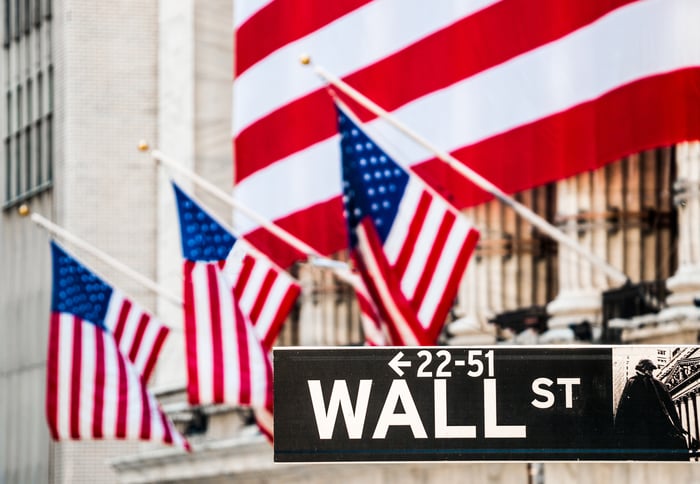For the past 125 years, arguably no stock index has been more widely followed than the Dow Jones Industrial Average (^DJI -1.23%). The Dow Jones, which is comprised of 30 profitable, time-tested, multinational businesses, has become a barometer to gauge the health of the U.S. stock market.
It's also home to some serious value, at least according to a handful of Wall Street analysts and investment banks. Wall Street's high-water one-year price target for each of the following four Dow stocks implies upside ranging from 48% to as much as 58%.

Image source: Getty Images.
Intel: Implied upside of 55%
To begin with, at least one Wall Street analyst foresees some significant upside in semiconductor giant Intel (INTC 0.91%). According to Robert W. Baird analyst Tristan Gerra, Intel could hit $85 a share, representing upside of 55% over the next year.
Among Gerra's chief arguments is that Intel will likely make a big acquisition to shore up its Foundry Services operations. It just so happens that The Wall Street Journal reported last week that Intel is tinkering with the idea of a $30 billion deal to acquire GlobalFoundries, a specialty chip-production company that Advanced Micro Devices spun off back in 2008. Going the acquisition route would emphasize Intel's renewed commitment to keep chip production under its own control, rather than outsource it. Depending on geopolitical or supply and demand concerns, that could become a major competitive edge for Intel.
Even though personal-computing chip demand tends to ebb and flow, the future for Intel will likely hinge on data centers. Despite a double-digit percentage decline in data center revenue in the first quarter, demand for storage, processing, and software solutions are only going to increase over the long run as businesses make the shift online and into the cloud. Intel's road will undoubtedly be bumpy as it spends big bucks on 7nm chip innovation, but it should prove well worth it.
An $85 price target may well make sense for Intel, but likely not over the next year.

Image source: Getty Images.
Walgreen Boots Alliance: Implied upside of 48%
Healthcare stocks are also expected to get in on the action. Pharmacy chain Walgreens Boots Alliance (WBA -0.08%) has a high-end price target of $68 from analysts at Robert W. Baird. This portends up to 48% upside over the next 12 months.
The bullishness surrounding Walgreens likely has to do with the company's ongoing multipoint turnaround plan. By fiscal 2022, Walgreens should be realizing more than $2 billion in annual cost savings, yet at the same time will benefit from hefty investments in digitization. Although online sales only comprise a small portion of total sales, direct-to-consumer is an area of considerable growth opportunity for the generally slow-growing pharmacy chain.
Perhaps even more exciting is the partnership between Walgreens Boots Alliance and VillageMD. This duo plans to open as many as 700 full-service clinics (co-located in Walgreens' stores) in more than 30 markets throughout the United States by mid-decade. Whereas most in-store clinics cater to vaccines or a sniffle, doctor-led full-service practices inside Walgreens have the potential to facilitate repeat business and drive patients right to Walgreens' high-margin pharmacy.
As a shareholder, I'm enthusiastic about Walgreens' future. But I suspect it'll take longer than 12 months to reach $68.

Image source: Getty Images.
Dow Inc.: Implied upside of 58%
When it comes to Dow stocks with supercharged return potential, chemicals company Dow Inc. (DOW -0.49%) takes the cake. If the Street-high price target of $95 were to come to fruition, Dow would return 58% for its shareholders over the coming year.
The biggest growth driver for Dow is going to be a continued U.S. and global recovery (Dow has a manufacturing presence in 31 countries). If economic activity continues to pick up, not only will the company recognize strong demand for its packaging, specialty plastics, performance materials, and coatings, but this demand will actually improve pricing power for Dow's material solutions. The first quarter saw demand and pricing power improve across all operating segments.
Beyond just growing demand, Dow is taking other actions to improve its bottom line. The company has invested aggressively in digitization, while at the same time restructuring its operations to eventually reduce costs by approximately $300 million on an annual basis. Perhaps most important, capacity expansion for its material solutions will allow Dow to meet increased demand as the U.S. and global economy heat up.
The bottom line is that Dow is a solid cyclical operating model that'll deliver incremental profit improvements in the years that lie ahead. But as a generally slower-growth business, $95 seems far too aggressive a price target over the coming 12 months.

Image source: Getty Images.
Chevron: Implied upside of 54%
Lastly, at least one Wall Street investment bank is counting on a gusher of a year from integrated oil and gas giant Chevron (CVX 0.31%). If the high-end price target of $152 proves accurate, Chevron could gallop higher by 54% over the coming year.
To state the obvious, Chevron benefits from its integrated operating model. Even though higher crude prices are more favorable given the juicier margin potential of its upstream (drilling and exploration) operations, the company is hedged by controlling petrochemical plants and refineries (downstream operations). When the price of crude declines, the input costs for its downstream operations fall, as well, pushing profitability and margins higher.
The Chevron growth story also can't be told without making mention of its generally superior balance sheet. Whereas most major oil stocks are weighed down by debt, Chevron's debt-to-equity of 34% is considerably lower than many of its peers. When combined with aggressive capital expenditure reductions in the near-term, Chevron looks to have considerably better financial flexibility than other oil majors.
Ultimately, Chevron's success will be dependent on a continued rebound in the U.S. and global economy. While history does indicate that periods of economic expansion usually last years, Wall Street's high-end price target should, once again, be taken with a grain of salt over the next year.





